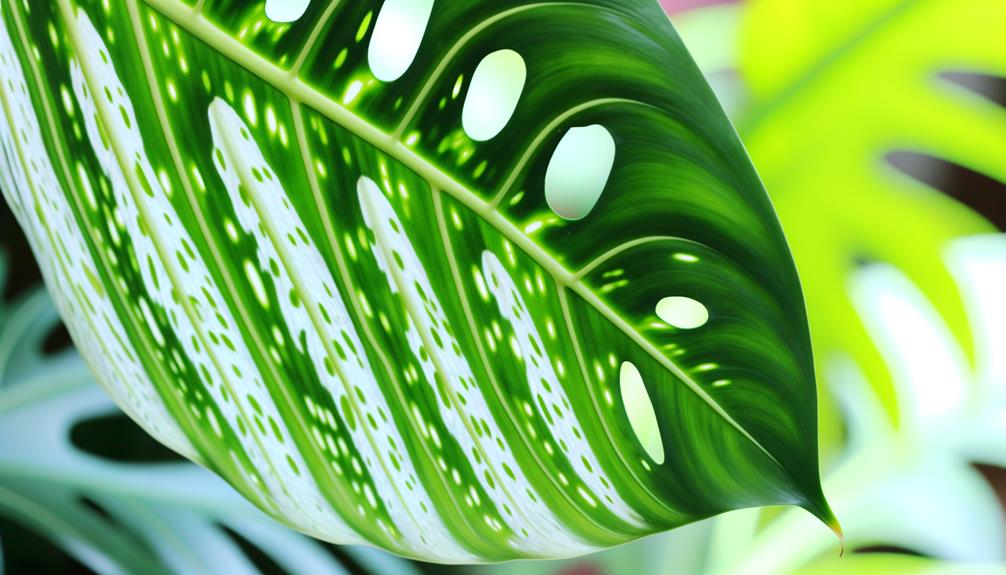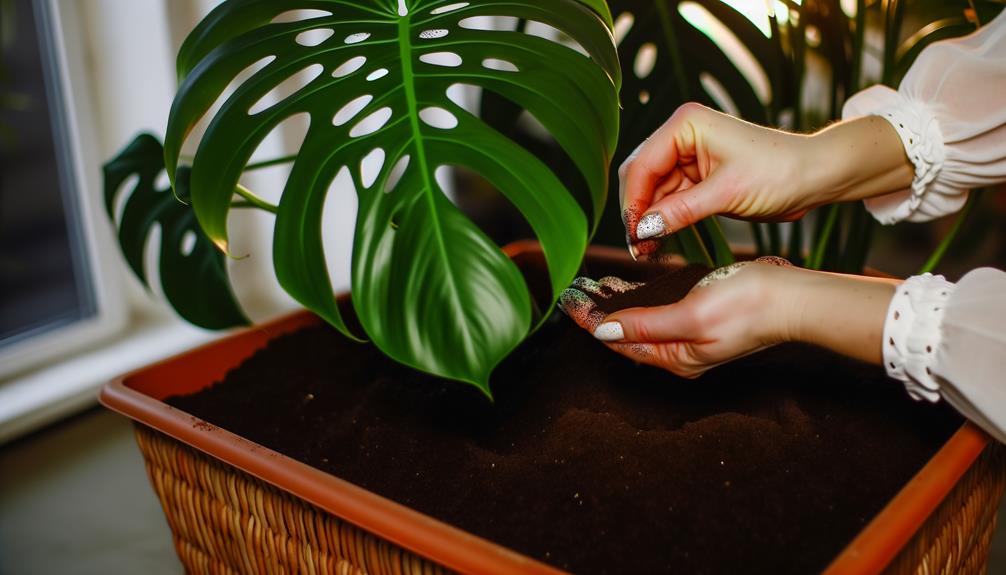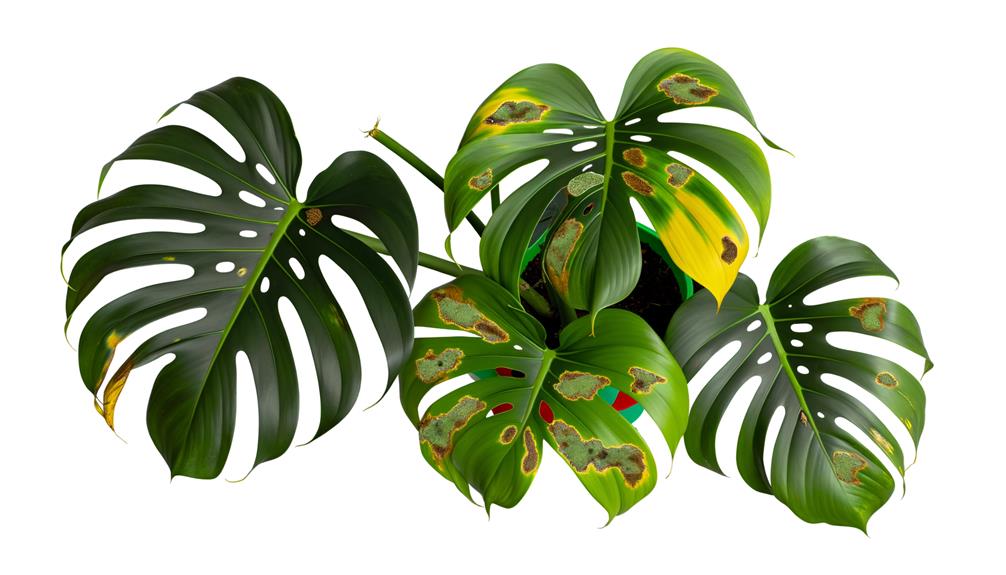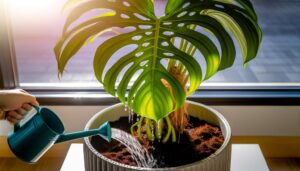Monstera Deliciosa Albo Large Form: Growing Tips!
Monstera deliciosa ‘Albo Large Form’ boasts striking chimeral variegation, with sections of the leaves lacking chlorophyll. This stunning variegation reduces photosynthetic efficiency, so place your plant in bright, indirect light to mimic natural forest canopy conditions.
Use well-draining soil with a pH of 5.5-7.0 and water when the top 2-3 inches are dry. Fertilize every 4-6 weeks with a balanced 20-20-20 NPK fertilizer.
Prune selectively and propagate from stem cuttings with nodes. Use proper pest management techniques to avoid damage.
Keep exploring to discover detailed tips on keeping your Monstera thriving.

Key Takeaways
- Albo variegation in Monstera deliciosa results from a genetic mutation causing distinct white and green leaf patterns.
- Position Monstera Deliciosa Albo in bright, indirect light to avoid leaf damage and ensure optimal growth.
- Keep soil consistently moist but not waterlogged, using well-draining potting mix to prevent root rot.
- Fertilize every 4-6 weeks with a balanced 20-20-20 NPK fertilizer during the growing season.
- Propagate using stem cuttings with nodes, ensuring optimal humidity and indirect light for successful root development.
Understanding Albo Variegation

Albo variegation in Monstera deliciosa is a genetic mutation characterized by the presence of white or cream-colored patches on the leaves due to the lack of chlorophyll in some cells.
This mutation, known as chimeral variegation, results from the coexistence of genetically distinct cell lines within the plant. You’ll notice that these white sections lack chlorophyll, the pigment essential for photosynthesis.
As a result, variegated sections are more prone to damage from direct sunlight and require careful attention. The distribution of variegation can vary, with some plants exhibiting large, irregular patches while others display a marbled pattern.
These white areas not only reduce the overall photosynthetic efficiency but also make the plant more susceptible to stress and slower growth.
Ideal Light Conditions
For best growth, position your Monstera deliciosa ‘Albo Variegata’ in bright indirect light to mimic its natural understory habitat.
Direct sunlight can cause photodamage, leading to chlorosis and necrosis of the variegated leaves.
Maintain consistent light exposure to preserve its striking white and green variegation.
Bright Indirect Light
Monstera deliciosa thrives in bright indirect light, where it receives ample illumination without being exposed to direct sunlight, which can cause leaf burn. This environment mimics its natural habitat under the forest canopy.
You should place your Monstera near a north or east-facing window. The light intensity should range between 10,000 to 20,000 lux. Use a light meter to ensure best conditions.
Here’s a quick reference guide:
| Light Source | Intensity (lux) | Placement Suggestion |
|---|---|---|
| East-facing window | 10,000 – 20,000 | 1-2 feet away |
| North-facing window | 5,000 – 10,000 | Directly in front (no curtains) |
| Artificial grow light | 15,000 – 20,000 | 12 inches above the plant |
| West-facing window | 20,000 – 30,000 | 3-4 feet away with sheer curtain |
| South-facing window | 20,000 – 50,000 | 4-5 feet away with sheer curtain |
Ensure your plant receives consistent light for best growth.
Avoid Direct Sunlight
Direct sunlight can scorch the delicate fenestrated leaves of Monstera deliciosa, leading to irreversible damage and unsightly leaf burn. You should place your Monstera deliciosa ‘Albo’ in an environment that mimics its natural habitat, which is the understory of tropical rainforests. Bright, indirect light is ideal.
Direct sun exposure can cause cellular damage in the chlorophyll, manifesting as brown, crispy patches. Filtered light through a sheer curtain or positioning your plant a few feet away from a south or west-facing window guarantees adequate photosynthesis without harmful UV exposure. Monitoring light intensity with a light meter can help you maintain appropriate levels.
Watering Requirements

To sustain peak health for your Monstera deliciosa ‘Albo Variegata’, make certain that the soil stays consistently moist but not waterlogged, utilizing a well-draining potting mix to prevent root rot. Water the plant when the top 2-3 inches of soil feel dry to the touch.
Overwatering can lead to Phytophthora root rot, while underwatering may cause leaf curling and browning. Use tepid, dechlorinated water to avoid shocking the roots and ensure prime nutrient absorption.
During the growing season (spring and summer), you might need to water more frequently due to increased transpiration rates. In contrast, reduce watering during the dormant period (fall and winter) to accommodate the plant’s slower growth rate.
Regularly check moisture levels to sustain ideal hydration.
Soil and Potting Mix
Securing ideal watering practices goes hand-in-hand with selecting an appropriate soil and potting mix for Monstera deliciosa ‘Albo Variegata’. The soil should be airy, well-ventilated, and rich in organic matter. You’ll want to use a mix combining peat moss, perlite, and orchid bark.
Peat moss retains moisture while providing essential nutrients. Perlite guarantees adequate drainage, preventing root rot. Orchid bark adds structure, mimicking the plant’s natural epiphytic environment.
Aim for a pH level between 5.5 and 7.0 to maintain optimum nutrient availability. A well-draining mix promotes healthy root development and aeration. Avoid heavy, compact soils as they can lead to waterlogging and root suffocation. Regularly check the soil’s condition and adjust as needed to sustain ideal growth conditions.
Fertilization Tips

Providing consistent and balanced fertilization is crucial for the vibrant growth and variegation of Monstera deliciosa ‘Albo Variegata’. Use a water-soluble, balanced fertilizer with a 20-20-20 NPK ratio. Apply it every 4-6 weeks during the growing season, which typically spans from spring to early fall.
Make sure the fertilizer contains micronutrients such as iron (Fe), manganese (Mn), and magnesium (Mg) to support chlorophyll production. Avoid over-fertilizing, as it can lead to salt buildup in the soil, causing root burn and leaf discoloration. Dilute the fertilizer to half-strength to prevent nutrient overload.
Monitor the plant’s response; if you notice yellowing leaves, it might indicate nutrient deficiency, requiring adjustments in your fertilization schedule.
Pruning and Propagation
Pruning Monstera deliciosa ‘Albo Variegata’ involves selectively removing stems and leaves to promote bushier growth and maintain the plant’s variegated appearance. Use sterilized pruning shears to cut just above a node, targeting older or leggy stems. This will stimulate new growth, enhancing chlorophyll distribution in variegated sections.
For propagation, select a healthy stem with at least one node and aerial root. Cut below the node, then place the cutting in water or a well-aerated soil mix. Ensure optimal humidity and indirect light to promote root development. After roots form, transplant the cutting into well-draining soil.
Consistent care will guarantee your new Monstera deliciosa ‘Albo Variegata’ thrives, mirroring the parent plant’s striking variegation.
Common Pests and Problems

When caring for Monstera Deliciosa Albo Large Form, you’ll likely encounter common pests like scale insects (Coccoidea) which attach to stems and leaves, causing damage by sucking sap.
Root rot, often caused by overwatering and pathogens like Pythium species, leads to decaying roots and stunted growth.
Additionally, leaf yellowing, or chlorosis, can signal nutrient deficiencies, improper light conditions, or pest infestations.
Scale Insect Infestation
Scale insects, like *Coccus hesperidum*, can severely harm Monstera Deliciosa Albo Large Form by sucking sap and excreting honeydew, which promotes sooty mold growth. These pests attach themselves to the plant’s stems and leaves, creating small, dome-shaped structures that are often brown or tan.
You’ll notice a decline in your plant’s vigor as the infestation progresses, appearing as yellowing leaves and stunted growth. To combat this, regularly inspect your plant for signs of infestation.
You can manually remove the scales with a cotton swab dipped in rubbing alcohol. For severe cases, apply an insecticidal soap or a systemic insecticide containing imidacloprid. Early detection and prompt treatment are essential to maintaining your plant’s health.
Root Rot Issues
After addressing scale insect infestations, it’s equally important to monitor for root rot, a common issue in Monstera Deliciosa Albo Large Form caused by pathogens such as *Phytophthora* spp. You’ll notice root rot when the roots become mushy, blackened, and emit a foul odor.
This condition is often exacerbated by overwatering and poor drainage. To prevent it, verify your plant’s soil mix is well-draining and avoid letting the plant sit in waterlogged conditions. If root rot is detected, promptly remove the affected roots with sterilized tools and consider repotting the plant in fresh, well-draining soil.
Using fungicides specifically designed for *Phytophthora* can also help manage the issue. Regularly inspecting the roots can catch early signs before the problem escalates.
Leaf Yellowing Causes
Leaf yellowing in Monstera Deliciosa Albo Large Form often signals underlying issues such as nutrient deficiencies, pest infestations like spider mites (*Tetranychus urticae*), or environmental stressors. Start by checking for chlorosis, which indicates a lack of essential nutrients like nitrogen, magnesium, or iron.
Inspect the plant closely for tiny, web-spinning spider mites, which feed on cell sap, causing stippled leaf surfaces. To manage them, use insecticidal soap or neem oil.
Assess environmental conditions like light exposure and watering frequency; too much direct sunlight or inconsistent watering can stress the plant. Maintaining ideal conditions (bright, indirect light, consistent moisture) and regular monitoring will help you prevent and address leaf yellowing effectively.
Monstera Albo Small Form Vs Large
| Feature | Monstera Albo Small Form | Monstera Albo Large Form |
|---|---|---|
| Leaf Shape | Oval-shaped leaves | Rounder, heart-shaped leaves |
| Growth Habit | Grows vertically; climbing habit | Crawls horizontally; can climb |
| Node Spacing | Longer internodal spacing (leggier) | Tighter internodal spacing |
| Commonality | More common; widely propagated | Extremely rare; often grown from seed |
| Variegation | Variegation is more consistent | Variegation is less common |
| Availability | Easier to find in nurseries | Rare and harder to find |
Conclusion
To sum up, caring for a Monstera deliciosa ‘Albo Variegata’ demands meticulous focus on light, water, soil, and nutrients.
Did you know that variegated types such as ‘Albo’ can be up to 30% less effective at photosynthesis because of the absence of chlorophyll in white patches?
By offering optimal conditions, you’re guaranteeing your plant flourishes despite this obstacle.
Regular pruning and careful pest control will maintain your Monstera’s gorgeous and robust look, enhancing its impressive appearance.






